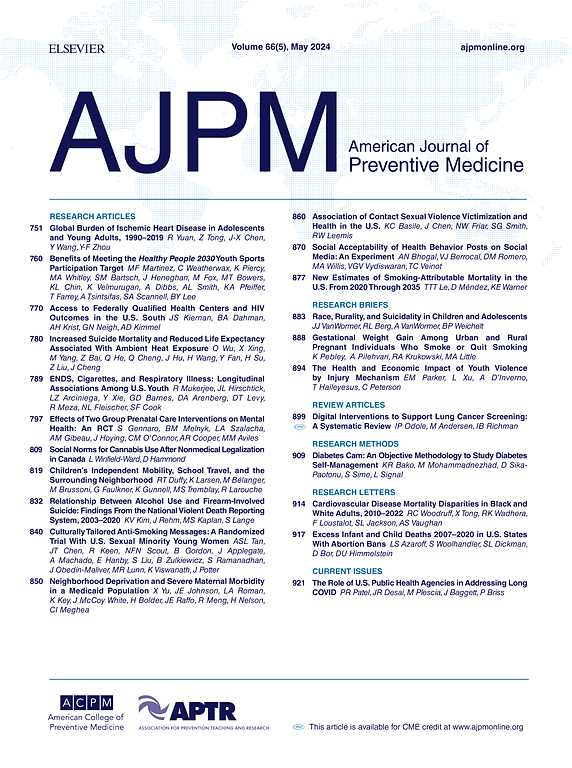Self-Rated Health by Time Since Smoking Cessation
IF 4.5
2区 医学
Q1 MEDICINE, GENERAL & INTERNAL
引用次数: 0
Abstract
Introduction
Although the physiologic benefits of quitting smoking are well established, less is known about how those who formerly smoked perceive these benefits over time. This study investigates the association between time since smoking cessation and self-rated health in a nationally representative sample and examines how predicted self-rated health varies by age, area-level deprivation, and education.
Methods
Data were drawn from the 2017, 2018, 2019, and 2021 waves of the Scottish Health Survey, yielding a sample of 5,701 adults aged ≥16 years who had formerly smoked. The primary outcome was self-rated health, grouped as very good/good, fair, or bad/very bad. The main exposure was time since quitting smoking, categorized as <2 years, 2 to <5 years, 5 to <10 years, 10 to <20 years, and ≥20 years. Generalized ordered logistic regression was used to estimate crude and AORs for self-rated health. Predictive margins were calculated to assess variation across sociodemographic subgroups. All analyses were conducted in 2025.
Results
Longer cessation duration was associated with significantly lower odds of reporting poorer self-rated health. Compared with those who had quit within the past 2 years, AORs were 0.81 (95% CI=0.62, 1.06; p=0.125) for those aged 2 to <5 years, 0.75 (95% CI=0.58, 0.97; p=0.027) for those aged 5 to <10 years, 0.63 (95% CI=0.49, 0.80; p<0.001) for those aged 10 to <20 years, and 0.45 (95% CI=0.36, 0.58; p<0.001) for those aged ≥20 years. When modeled as a continuous ordinal variable, each additional cessation category was associated with lower odds of poorer self-rated health (AOR=0.82; 95% CI=0.78, 0.87; p<0.001). Predicted probabilities of reporting good or very good health increased with time since quitting across all subgroups (p<0.001). Among adults aged 45–64 years, probabilities rose from 59.7% (95% CI=53.6%, 65.9%) for those aged <2 years to 72.2% (95% CI=69.4%, 74.9%) for those aged ≥20 years. Among those in the least deprived areas, the increase was from 64.4% (95% CI=54.0%, 74.8%) to 76.3% (95% CI=73.2%, 79.5%), and among individuals with higher education, it was from 65.7% (95% CI=58.1%, 73.4%) to 79.1% (95% CI=76.6%, 81.6%).
Conclusions
Longer time since smoking cessation is associated with more favorable self-rated health, suggesting a graded, perceived benefit over time. However, these perceived subjective health gains are not evenly distributed because individuals in disadvantaged groups continue to report lower probabilities of good health even after long-term cessation.
自戒烟以来按时间自我评估的健康状况。
导读:虽然戒烟对生理的好处是众所周知的,但人们对那些曾经吸烟的人如何随着时间的推移看待这些好处知之甚少。本研究在一个具有全国代表性的样本中调查了戒烟后的时间与自评健康(SRH)之间的关系,并研究了SRH的预测如何随年龄、地区贫困和教育程度而变化。方法:数据来自2017年、2018年、2019年和2021年的苏格兰健康调查,样本为5701名16岁及以上的成年人,他们以前吸烟。主要结果是自我评价的健康状况,分为非常好/好、一般、差/非常差。主要暴露于戒烟后的时间,分类如下:戒烟时间越长,报告自我评价健康状况较差的几率显著降低。与过去两年内戒烟者相比,调整后的or为0.81 (95% CI: 0.62-1.06;p=0.125) 2到结论:戒烟时间越长,自我评价的健康状况越好,这表明随着时间的推移,人们会感受到一种分级的、可感知的益处。然而,这些感知到的主观健康收益并不是均匀分布的,因为弱势群体的个人即使在长期戒烟后仍然报告健康状况良好的可能性较低。
本文章由计算机程序翻译,如有差异,请以英文原文为准。
求助全文
约1分钟内获得全文
求助全文
来源期刊

American Journal of Preventive Medicine
医学-公共卫生、环境卫生与职业卫生
CiteScore
8.60
自引率
1.80%
发文量
395
审稿时长
32 days
期刊介绍:
The American Journal of Preventive Medicine is the official journal of the American College of Preventive Medicine and the Association for Prevention Teaching and Research. It publishes articles in the areas of prevention research, teaching, practice and policy. Original research is published on interventions aimed at the prevention of chronic and acute disease and the promotion of individual and community health.
Of particular emphasis are papers that address the primary and secondary prevention of important clinical, behavioral and public health issues such as injury and violence, infectious disease, women''s health, smoking, sedentary behaviors and physical activity, nutrition, diabetes, obesity, and substance use disorders. Papers also address educational initiatives aimed at improving the ability of health professionals to provide effective clinical prevention and public health services. Papers on health services research pertinent to prevention and public health are also published. The journal also publishes official policy statements from the two co-sponsoring organizations, review articles, media reviews, and editorials. Finally, the journal periodically publishes supplements and special theme issues devoted to areas of current interest to the prevention community.
 求助内容:
求助内容: 应助结果提醒方式:
应助结果提醒方式:


